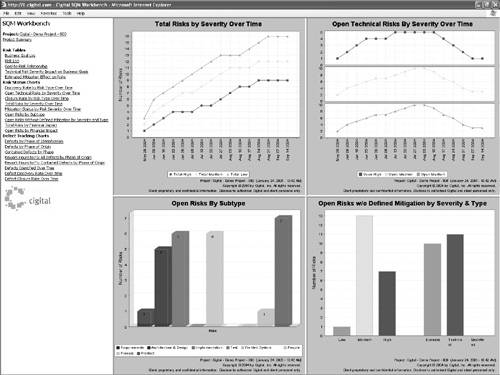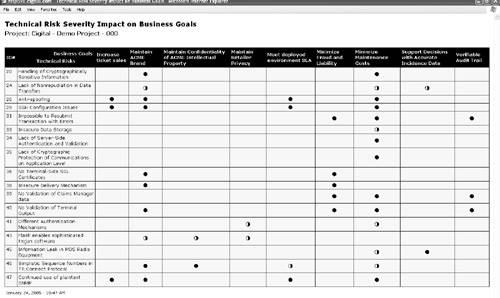The Cigital Workbench
| A key requirement for putting the RMF into practice is automating aspects of the process. Without automation, the elaborate steps of the RMF can become tedious. Those aspects best suited for automation include tracking, storing, and manipulating data about risks; displaying and measuring data about risks; and providing critical information and automation regarding processes. Note that automation like this supports the notion of ongoing, continual updating and refinement of risk data over time. Cigital provides professional services based on applying the RMF philosophy. We created and use a toolset called the Workbench to make our jobs as consultants more efficient, effective, and consistent. The Workbench, in some sense, is an automated RMF. It is a combination of simple tools and automated processes used to help consultants assess software quality. The Workbench has three major components:
Figure 2-3. The Cigital Workbench risk management dashboard displays information about software risk and business impact over time. These components capture fundamental aspects of the RMF. Central to the idea of the Workbench is the notion of tracking information about risks. The Workbench allows for the automatic creation of technical risk Figure 2-4. The Cigital Workbench allows technical risks and business risks to be tracked over time. The risk log here provides a snapshot of risk status. Tracking risk status is central to the success of the RMF process. Figure 2-5. Technical risks must be tied to business goals or wither under the glare of the ultimate question: "Who cares?" |
EAN: 2147483647
Pages: 154
 business risk associations, impact analysis, and ranking. Basic risk information is available in a risk log (Figure 2-4). Information about the relationship between business goals and technical risks is displayed in one of many available tables (Figure 2-5).
business risk associations, impact analysis, and ranking. Basic risk information is available in a risk log (Figure 2-4). Information about the relationship between business goals and technical risks is displayed in one of many available tables (Figure 2-5).